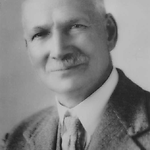Person
Chapman, Frederick (1864 - 1943)

Chapman, Frederick Portrait
Details
- Born
- 13 February 1864
Camden Town, London, England - Died
- 10 December 1943
Kew, Victoria, Australia - Occupation
- Palaeontologist
Summary
Frederick Chapman was Palaeontologist to the National Museum, Melbourne from 1902-1927 and served as the first Commonwealth Palaeontologist 1927-1935. He trained as a teacher of geology and physiography at the Royal College of Science, London and was Assistant to Professor J.W. Judd in the geology department of the College from 1881. His research interest was in Foraminifera and he became a world leader in this field. His books included The Foraminifera: an introduction to the study of the Protozoa (1902) and Australasian fossils (1914). On being appointed Palaeontologist of the National Museum of Victoria in 1902 Chapman had the task of amalgamating and arranging the collections of fossils from the Geological Survey of Victoria and the University of Melbourne. As the first Commonwealth Palaeontologist his work involved the examination of fossils from bore material submitted in the search for oil. Chapman took a leading role in scientific organisations in Victoria, serving terms as President several societies and Honorary curator of the Maranoa Gardens in the Melbourne suburb of Balwyn.
Details
Chronology
- 1892 - 1943
- Award - Fellow, Royal Microscopical Society, London
- 1896 - 1943
- Career position - Associate, Linnean Society, London
- 1899
- Award - Lyell Prize for research, Geological Society, London
- 1902 - 1927
- Career position - Palaeontologist, National Museum of Victoria
- 1919 - 1920
- Career position - President, Microscopical Society of Victoria
- 1919 - 1920
- Career position - President, Field Naturalists Club of Victoria
- 1920 - ?
- Career position - Member, International Commission on Zoological Nomenclature
- 1920 - ?
- Career position - Honorary Palaeontologist, Geological Survey of Victoria
- 1920
- Award - David Syme Research Prize, University of Melbourne
- 1920 - 1932
- Career position - Lecturer on palaeontology (part-time), University of Melbourne
- 1922
- Career event - Elected Member (Geology), Australian National Research Council
- 1926 - 1943
- Award - Honorary Fellow, Royal Society of South Australia
- 1927 - 1935
- Career position - First Commonwealth Palaeontologist
- 1929 - 1930
- Career position - President, Royal Society of Victoria
- 1930
- Award - Lyell Medal, Geological Society of London
- 1932
- Award - Clarke Medal, Royal Society of New South Wales
- 1932 - 1943
- Award - Honorary Fellow, Royal Society of New Zealand
- 1933 - 1943
- Award - Corresponding Member, Paleontological Society, U.S.A.
- 1936 - ?
- Career position - Honorary Palaeontologist, National Museum of Victoria
- 1937
- Career event - Fellow, Australian and New Zealand Association for the Advancement of Science (ANZAAS)
- 1941
- Award - Australian Natural History Medallion, Field Naturalist Club of Victoria
Related entries
Children
Published resources
Books
- Chapman, Frederick, Ostracoda (Sydney: Government Printer, 1919), 51 pp. Details
- Chapman, Frederick; and Parr, Walter James, Foramifera (Sydney: Government Printer, 1937). Details
Book Sections
- Crespin, Irene, 'Chapman, Frederick (1864-1943), palaeontologist' in Australian dictionary of biography, volume 7: 1891 - 1939 A-Ch, Bede Nairn and Geoffrey Serle, eds (Melbourne: Melbourne University Press, 1979), p. 612. http://www.adb.online.anu.edu.au/biogs/A070621b.htm. Details
Journal Articles
- 'Obituary: Frederick Chapman', Australian Journal of Science, 6 (4) (1944), 122. Details
Resources
- Wikidata, http://www.wikidata.org/entity/Q5497505. Details
- VIAF - Virtual International Authority File, OCLC, https://viaf.org/viaf/75891334. Details
- 'Chapman, Frederick (1864-1943)', Trove, National Library of Australia, 2009, https://nla.gov.au/nla.party-459065. Details
See also
- Kelly, Farley, 'Learning and Teaching Science: Women Making Careers 1890-1920' in On the Edge of Discovery: Australian Women in Science, Farley Kelly, ed. (Melbourne: Text Publishing Company, 1993), pp. 35-75. Details
Digital resources
Gavan McCarthy [P004098] and Helen Cohn
Created: 20 October 1993, Last modified: 6 October 2023
- Foundation Supporter - Royal Society of Victoria
